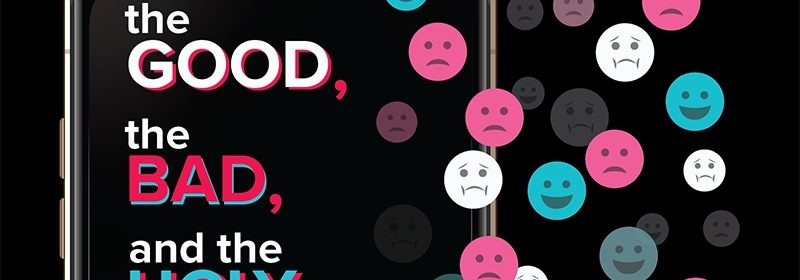TikTok Trends: Lettuce Water, Cyst Smacking, and Period Pains

Spring is the time for new beginnings, cleaning out your dusty musty basement, battling seasonal allergies, and, of course, discovering the latest TikTok trends.
With potentially permanent daylight savings on the table, that extra time spent luxuriating in the sunshine could mean more time to scroll (and scroll and scroll) through the latest health fads on the platform — for better or for worse.
The Good: Doctor Explains Menstrual Pain in an Unexpected Place
For a long time, menstrual cycles were considered taboo, and discussing them is still seen as inappropriate in many parts of the world. Organizations and online resources like Clue or Flo are seeking to normalize period-talk. Pixar has jumped on board too with their latest film, Turning Red, which depicts a 13-year-old’s experience getting her first period. With a 95% rating on Rotten Tomatoes, it’s clear that the public is willing to talk about periods.
Many people feel shame around discussing their periods, but this is something that social media has actually handled positively (for once).
Karan Raj, MD, a National Health Service surgeon and educator at Imperial College London, UK, uses his TikTok account to educate his followers and explain health concerns and issues using his platform. Raj stitched this video from someone else that was captioned, “When you’re on your [period] and feel the stab in your booty.”
In his video, Raj uses anatomical diagrams to explain exactly what’s going on with this pain in the butt. The pain, which Raj explains is called proctalgia fugax, is caused by a type of hormone released during menstruation called prostaglandins. Prostaglandins tell the uterus to contract and shed its lining, but the uterus isn’t the only part of the body receiving that message from the prostaglandins.
“The prostaglandins also cause contraction of the rectum, pelvic floor muscles, and muscles around the anal canal,” Raj tells viewers. “These intense contractions can cause muscle spasms and anal cramps.”
The Bad: Lettuce Water Sleep Aid
This video from Elliott Norris (@callmebelly) shows him preparing an unusual sleep aid. It’s one of many videos of people trying the same trend, usually with the tag #lettucewater attached.
Like Elliott explains, the rumor is that boiling romaine lettuce and then drinking the water is a way to help one fall asleep faster, or sleep better at night. At the end of the video, Elliott even said that it worked for him. So where does this come from, and is it just a placebo?
Videos on TikTok recreating this trend cite a 2017 study titled, “Sleep-inducing effect of lettuce (Lactuca sativa) varieties on pentobarbital-induced sleep” (there’s even a New York Times article about it). The star of the study is lactucarium, a milky white substance that’s found in lettuce, usually visible if you squeeze it or break the stalks. The study suggests that lactucarium has “sedative-hypnotic” properties after lettuce extract was used in tandem with pentobarbital on mice, and it was found that the mice’s sleep latency then decreased.
In an article from Parade discussing the trend, Rachel Salas, MD, MEd, weighs in. Salas is the assistant medical director at Johns Hopkins Center for Sleep and Wellness in Baltimore, so you could say she knows a thing or two about sleep. Her response to the mice study was that its limitations made the results not entirely reliable.
According to Salas, there was no control group, the extract the mice were given is much more concentrated than what’s found in lettuce, and the mice were given a sedative that was going to make them sleepy anyway: “The mice were drugged to put the animals to sleep soon after they took the lettuce water.”
So while Salas thinks it’s good that people are open to talking about sleeping solutions, “lettuce tea” just doesn’t have any evidence to back up what people claim it does.
The Ugly: Using a Book to Pop Ganglion Cysts
Everyone knows how popular pimple popping, blackhead squeezing, and cyst squashing are on social media. Dermatologist Sandra Lee, better known as Dr Pimple Popper, used her YouTube platform of the same name — which boasts over 7.42 million subscribers — to cinch a reality television show on TLC. Viewers on TikTok are no different and love the satisfying (and often gross) relief of clearing out a nasty pimple or two.
In this stitched TikTok from emergency medicine physician Fayez Ajib, DO, aka @lifeofadoctor, Ajib reacts to an original video of someone popping a ganglion cyst with a textbook.
There are plenty of other videos on TikTok of people using books to smack ganglion cysts, which develop on the wrist. People have looked for remedies for ganglion cysts since the 1700s, at which point many strange options arose, as discussed in BBC Future. The one that still holds up, however, is smacking the cyst with a heavy book, like a Bible (hence the ganglion cyst’s nickname, “Bible bump”).
In his video, Ajib explains why smacking the cyst is a bad idea, even if it appears to temporarily resolve the issue.
“Not only have people broken the delicate bones in their wrist from getting hit,” Ajib says, “but they actually have a high chance of recurrence. A doctor will actually remove the sac itself rather than just draining it from being hit.”
The lessons we glean from TikTok remain the same: leave it up to the professionals.
For more news, follow Medscape on Facebook, Twitter, Instagram, YouTube, and LinkedIn
Source: Read Full Article